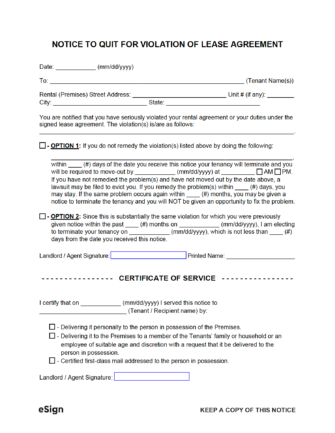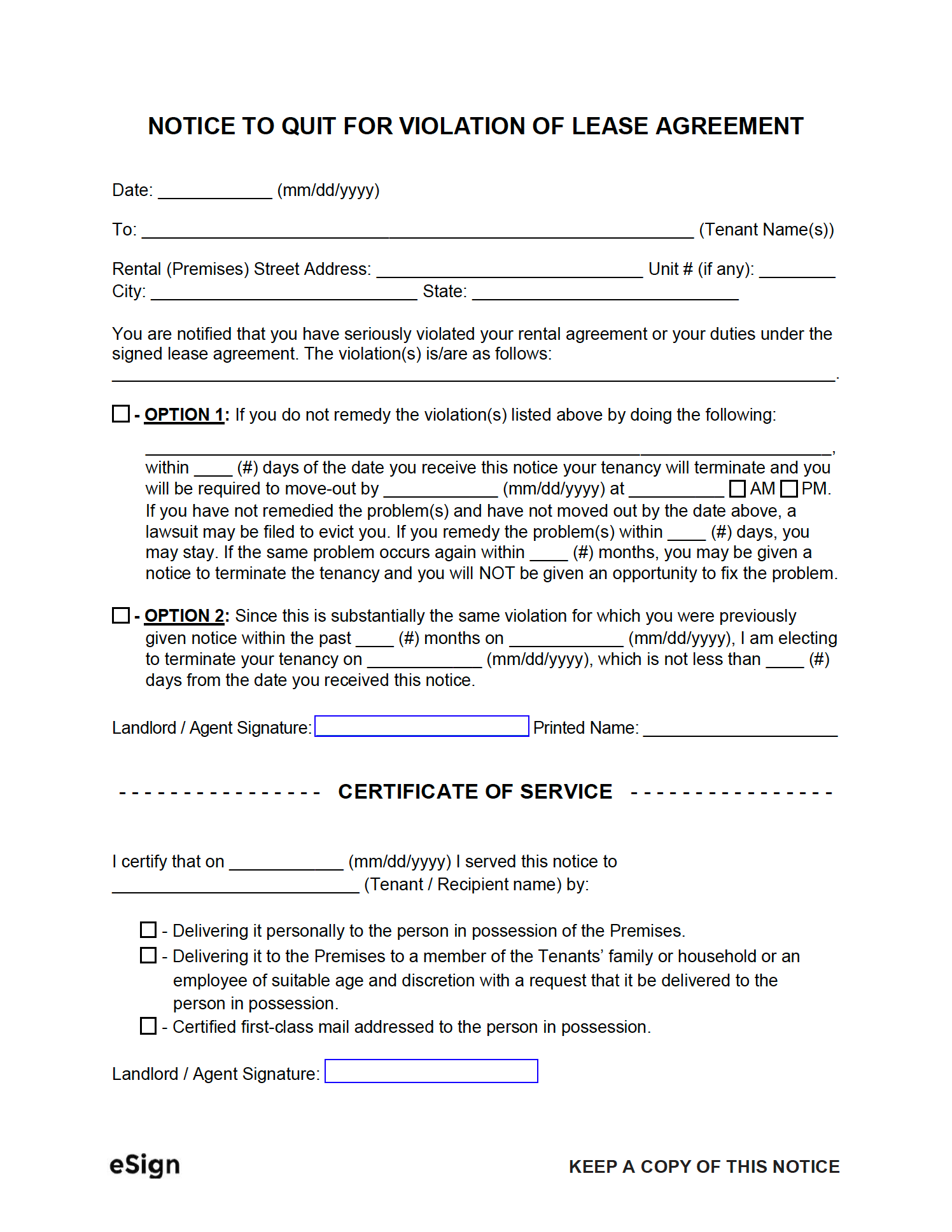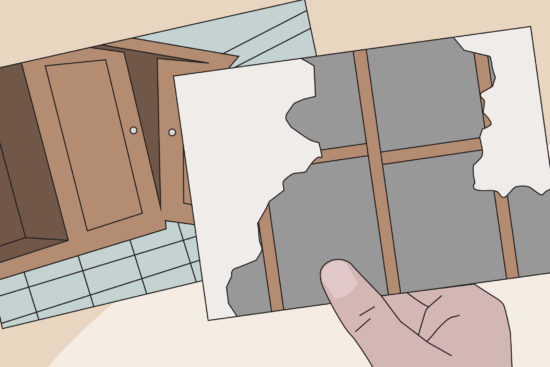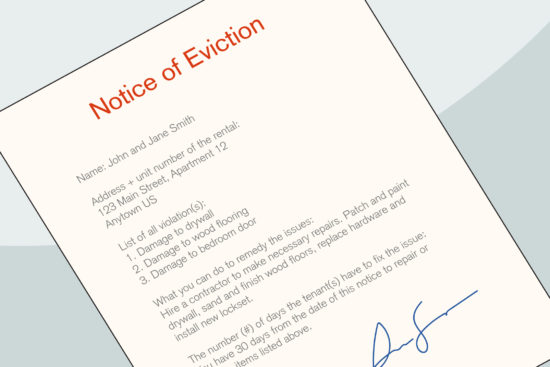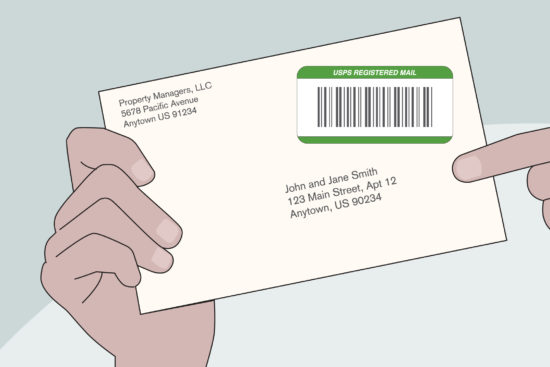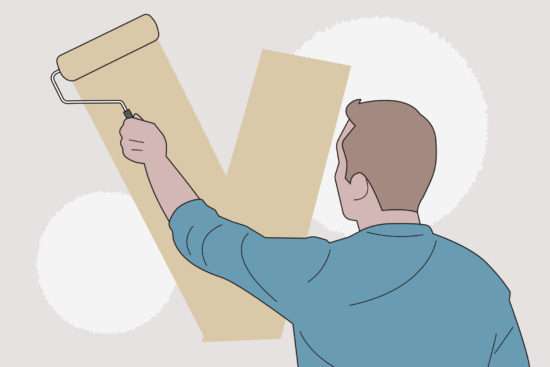A notice to quit for non-compliance is an eviction letter used to inform a tenant that they substantially breached their rental agreement. The document conveys the kind of violation, what the tenant needs to do to remedy the issue, and the timeframe in which they can address it.
For illegal tenant offenses, a notice to quit for illegal activity should be used instead.
Also known as a:
- Lease violation notice
- Cure or quit notice
By State
- Alabama
- Alaska
- Arizona
- Arkansas
- California
- Colorado
- Connecticut
- Delaware
- Florida
- Georgia
- Hawaii
- Idaho
- Illinois
- Indiana
- Iowa
- Kansas
- Kentucky
- Louisiana
- Maine
- Maryland
- Massachusetts
- Michigan
- Minnesota
- Mississippi
- Missouri
- Montana
- Nebraska
- Nevada
- New Hampshire
- New Jersey
- New Mexico
- New York
- North Carolina
- North Dakota
- Ohio
- Oklahoma
- Oregon
- Pennsylvania
- Rhode Island
- South Carolina
- South Dakota
- Tennessee
- Texas
- Utah
- Vermont
- Virginia
- Washington
- West Virginia
- Wisconsin
- Wyoming
Contents |
Sample
NOTICE TO QUIT FOR VIOLATION OF LEASE AGREEMENT
Date: [MM/DD/YYYY]
To: [TENANT NAME(S)]
Rental (Premises) Address: [STREET, CITY, STATE, ZIP]
You are notified that you have seriously violated your rental agreement or your duties under the signed lease agreement. The violation(s) is/are as follows:
[DESCRIBE VIOLATION(S)].
Check One:
☐ – OPTION 1 (Remedy): If you do not remedy the violation(s) listed above by [REMEDY TO VIOLATION(S)] within [#] days of the date you receive this notice, your tenancy will terminate, a lawsuit may be filed to evict you, and you will be required to move-out by [MM/DD/YYYY] at [HH:MM] ☐ AM ☐ PM. If the same problem occurs again within [#] months, you may be issued a notice to terminate the tenancy, and you will NOT be provided an opportunity to resolve the problem.
☐ – OPTION 2 (No Remedy): Since this is substantially the same violation for which you were previously given notice within the past [#] months on [MM/DD/YYYY], I am electing to terminate your tenancy on [MM/DD/YYYY], which is not less than [#] days from the date you received this notice.
Landlord/Agent Signature: _______________________
Printed Name: [LANDLORD NAME]
CERTIFICATE OF SERVICE
I certify that on [MM/DD/YYYY], I served this notice to [TENANT/RECIPIENT NAME] by:
☐ – Delivering it personally to the person in possession of the Premises.
☐ – Delivering it to the Premises to a member of the Tenants’ family or household or an employee of suitable age and discretion with a request that it be delivered to the person in possession.
☐ – Certified first-class mail addressed to the person in possession.
Landlord/Agent Signature: _______________________
Common Lease Violations
Once a tenant records their signature onto the lease, they are giving their legal affirmation that they will abide by all of the conditions within the contract. If they purposefully break a rule, they open themselves up to receiving an eviction notice (and possibly being evicted).
Prior to issuing a notice, the landlord needs to be 100% confident that they will go through with eviction proceedings. If the landlord sends an eviction notice but doesn’t file the paperwork after the deadline, the tenant will lose respect for the landlord, paving the way for more (and potentially worse) lease violations.
Some of the most common violations a landlord may need to evict for include:
- Unauthorized pets (dogs, cats, hamsters, etc.);
- Damage caused by decoration or recklessness;
- Noise or other complaints have been filed against the tenant(s);
- Long-term guests;
- Exceeding lease or local-mandated occupancy limits;
- Unauthorized subletting;
- Illegal activity (see eviction notice for illegal activity);
Requirements for Being “Evictable”
Landlords can’t evict for anything. If they try, they’ll wind up losing the case and being faced with punishments and/or having to pay for the tenant’s legal fees. In order to be evicted, the tenant has to be causing the landlord monetary damage (in the form of damage to the property or unpaid rent) OR they are disrupting other tenants on a regular basis.
How to Evict for Non-Compliance
While evicting a tenant for non-compliance is a similar process to evicting for unpaid rent, they differ in that unpaid rent is easily provable, whereas proving a lease violation isn’t always as straightforward.
Step 1 – Collect Proof
Even if a landlord has personally seen the tenant break the lease, they’ll need to prove the tenant(s) conducted the action in a court of law. Photos, witness statements, and any documents pointing to the proof should be organized. While photos can be taken from outside of the residence without the tenant’s permission, the landlord will need to provide the tenant(s) with adequate notice before entering their property. This can pose to be tricky, as this gives the tenant time to temporarily “remedy” the problem in certain situations.
Step 2 – Complete the Notice
Download the notice and complete all the fields. The landlord/property manager should have the following information readily accessible:
- Name of the tenant(s);
- Address + unit number of the rental;
- List of all violation(s);
- What the tenant(s) can do to remedy the issues (if curable);
- The number (#) of days the tenant(s) have to fix the issue; and
- The signature of the landlord/property manager.
Step 3 – Deliver to Tenant
Depending on the state in which the rental unit is located, the landlord may be required to issue the notice in a certain manner. This commonly involves registered mail (a service provided through USPS), although some states may allow the landlord to tape it to the tenant’s door. Whatever option selected, landlords need to understand the importance of delivering it correctly, as one of the most common reasons an eviction is thrown out is because the landlord didn’t follow the process (as outlined by state law) correctly.
Step 4 – Give Them Time
So long the landlord issue a notice to quit that was curable, the tenant(s) have the time specified in the form to remedy the issues. This can include fixing any necessary damage, ceasing all excessive noise, removing pets, kicking out guests, or removing excessive vehicles from the premises. If the notice was sent as incurable, the tenant(s) have no other option but to pack up and leave the property within the time specified. If the tenant(s) are able to cure the issues, the landlord is required by law to hold off on evicting the tenant(s). However, many states have laws in place that make a second breach within a certain amount of time (commonly six months) an evictable offense that doesn’t warrant it to be curable.
Required Notice Periods: By State
How to Write
Download: PDF, Word (.docx), OpenDocument
Step 1 – Recipient
At the top of the form, enter the following information:
- The date (mm/dd/yyyy) the letter was completed;
- The names of all tenants; and
- The rental unit address (in full, including any unit/apt number).
Step 2 – Violation Description
Clearly state what violation the tenant(s) committed. It would be helpful to reference the rental agreement and point out the section (page and paragraph number) that the tenant violated.
Step 3 – Select Option 1 or Option 2
This section is where the landlord can choose to give the tenant(s) the option to correct their mistakes, known as “remedying” the lease.
Check option 1 if the violations committed are fixable (“curable”). Then, describe the actions the tenant(s) must take in order to fix the issue, followed by the number of days they have to complete said actions. Next, enter the date (and time) that the tenant(s) must move-out if they don’t remedy the lease in the timeframe provided.
Then, enter the number (#) of days the tenant(s) have to fix the issue (for a second time), followed by the number (#) of months the tenant(s) will be bound to making no further violations (or else they will be evicted).
Check option 2 if the notice is incurable, and the tenant(s) will be required to move out. Enter the number (#) of months since the last violation occurred, followed by the exact date (mm/dd/yyyy) of the previous infraction. Then, enter the date (mm/dd/yyyy) that the lease will be terminated and the number (#) of days between receipt of the notice and the termination date.
Step 4 – Landlord / Agent Signature
The landlord (or agent working on behalf of the landlord) will need to sign the form on the line provided below “Option 2.” This signature can be recorded by hand or by uploading the form to eSign and signing digitally.
Step 5 – Record of Service
The record of service is a section of the notice that is completed immediately after delivery (or making an attempt at delivery) to the tenant(s). It contains three (3) checkboxes pertaining to different methods of delivery. The landlord/agent can select any number of boxes. If the notice was delivered in person to the tenant(s) or a person that was residing on the premises, the person that received the notice should sign their name on the form.
